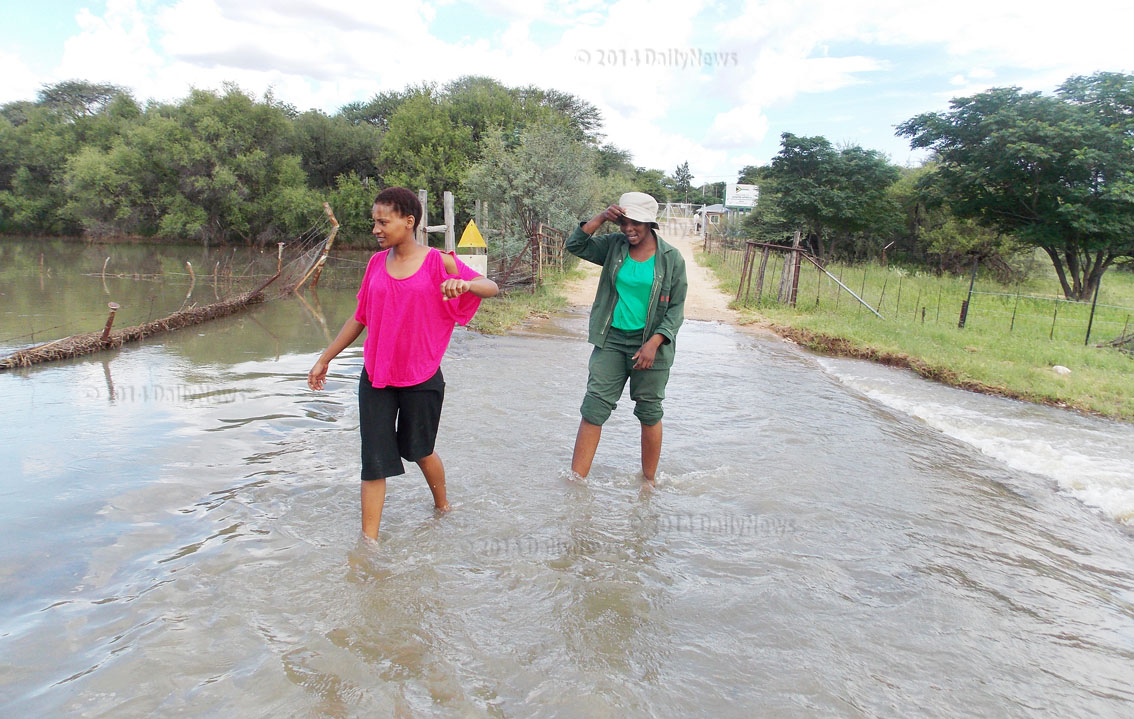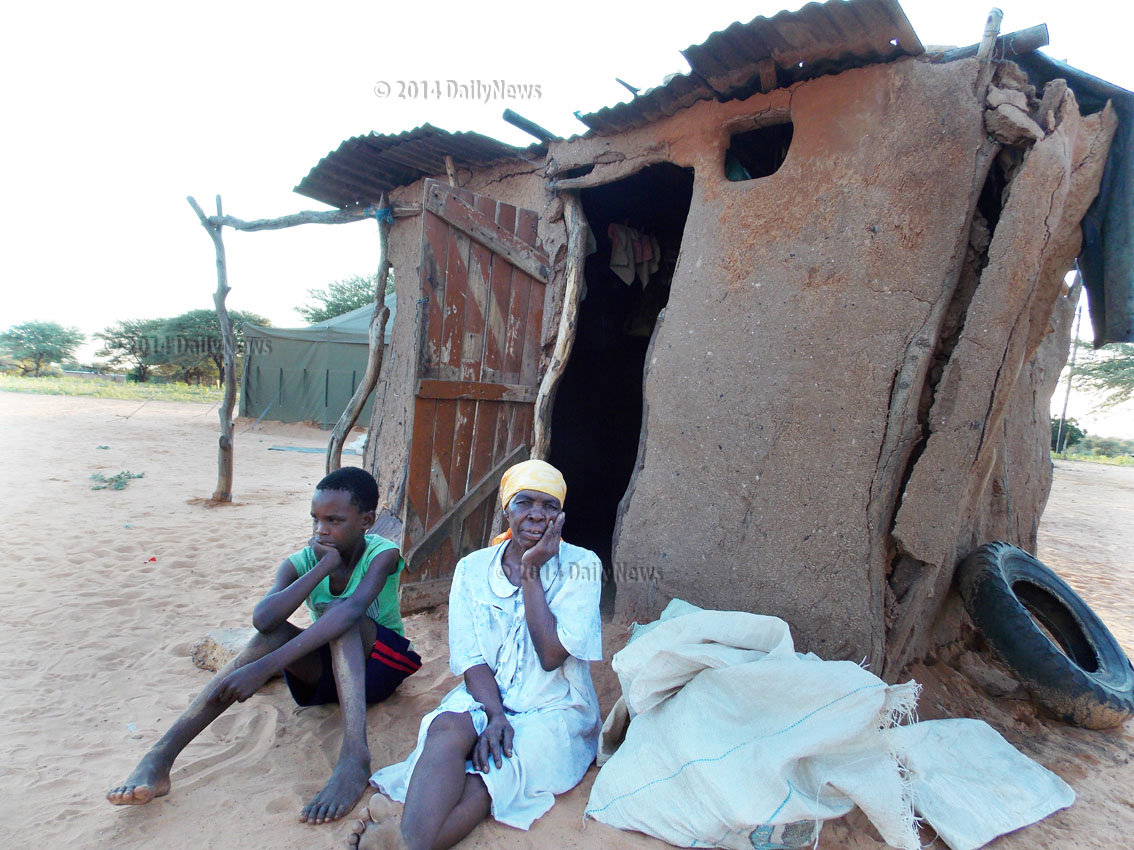The lament of Bray flood victims
24 Feb 2014
Recent heavy rains have left residents of Bray in the southern part of the Kgalagadi District devastated after destroying their houses and filling the Molopo River, which passes along their village and is the source of mud for building homes.
The residents woke up to sounds of collapsing walls of their mud houses as water flowed in.
For Mrs Keanole Sehularo, if there is any day she will never forget, it is February 1, 2014 when she was woken by an earth-shaking sound only to find that the walls of her mud room that she was sleeping in with her seven grandchildren, were falling.
With the sound giving her a temporary deafness, she could not hear her grandchildren crying she only noticed it when she saw the tears flowing from their eyes.
Mrs Sehularo (58) said she was left in a state of confusion, not knowing what to rescue first: her grandchildren or the possessions that she struggled to acquire by working hard for decades in neighbouring farms.
However, Mrs Sehularo prioritised the lives of her grandchildren. She removed them to the other mud room even though she doubted the strength of its wall because it was recently built in a hurry.
As she transferred the possessions into the other mud hut, she heard another ear-splitting sound that left her hopeless because the would-be refuge was also destroyed. Fortunately, no one was injured.
She learnt that she was homeless as the other five family members were lying packed on top of one other in the small incomplete brick house.
Left helpless and in an uneasy sense of foreboding, the Sehularo family were left in an open area showered by the heavy rains while their head, Keanole, had gone to ask for help from their neighbours.
The dark shadow imposed by the pregnant clouds left the Sehularos, with no option but to abandon their possessions to be destroyed by the raging waters, ran to their neighbours place where they lodged until the morning.
For those four hours, Sehularo said she never slept because she was frightened that her neighbour’s mud hut might also collapse. She said to defeat fear and stand firm in faith that there will be divine intervention.
“I meditated on a verse in the Bible, that says weeping may last in the evening but joy comes in the morning,” she said. “I therefore had strong faith that the worries and fears of this flood will only last during night hours, but when the morning breaks forth we shall sing a new song of joy.”
The Department of Social and Community Development gave the Sehularo family food but shelter remained a problem for some days because of congestion at a neighbour’s hut. Worse still, the only source of pit sand, the Molopo River, was flooding, meaning that Sehularo could not obtain soil to re-build her mud hut.
After seven days of homelessness, the disaster management team came to her aid with a tent for shelter. It was a one-month relief for the family because the tent had to be returned by the end of February. She complained that the time was too short because building materials were not available.
The river inaccessible for mud, Bray’s land is too small to rear livestock for their dung. Residents mostly used donkey dung but the donkeys died in the drought. And, the village did not have trees from which to cut poles. It pained Ms Sehularo to ponder what she would do once the disaster office took back the tent.
Farmers in the periphery of Bray did not allow the residents to fetch dung or poles from their farms. Despite the counseling, she said, her grandchildren often suffered nightmares and this caused her sleepless nights.
The disaster worsened her worries about the future of the grandchildren because lack of shelter would disturb their learning abilities at school. She was also worried that the stress of homelessness could cause her health complications
Therefore, Ms Sehularo appealed for help, any kind of help but especially shelter, for her family of 13. Ms Mmamaeyane Moshane was another victim of the Bray flood. Her hut was destroyed, alongside food and furniture. Her grandchildren always cry for food.
Another victim was Ms Kebafitlhetse Ramaesane. The disaster that hit her included a setback of wet 20 pockets of cement that she bought to build a brick house. For now, the dream of a modern house seemed to have gone away with the floods.
As a result of the heavy rains, the wall of Ms Sekhwana Bogwera’s cracked and she saw a snake slithering in.
While she was happy for a tent and food, Ms Bogwera lived in fear that the snake would glide out of the hut into the tent. The fear kept her from entering the hut to take whatever she needed.
Circumstances were worse for the 70-year-old , Mr Motshetshe Setshitshi. His two mud huts did not exist anymore, not to mention food and clothes. Ailments such as colds and breathing problems are troubling him. When the clouds gather, Mr Motshitshi’s stressful situation overwhelm him.
A social worker at Bray, Mr Baropi Sentlabane, said he helped the victims with whatever they needed, that is, food, shelter and counseling. The disaster management team was monitoring the situation.
Kgosi Lenyeletse Kgannyeng of Bray urged residents to have faith that God will protect and restore whatever they have lost to the heavy rains.
Mr Kgannyeng expressed his gratitude to the social work department and the disaster management operatives for helping victims without delay.
He pleaded with other Batswana to help Bray residents because the heavy rains and the floods worsened what he described as abject poverty. ENDS
Source : BOPA
Author : Johannah Martin
Location : TSABONG
Event : Feature article
Date : 24 Feb 2014







